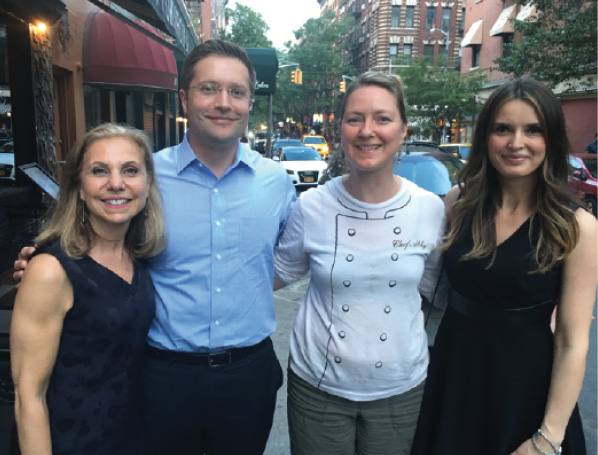
Welcome to another edition of “Ophthalmology 360º.” This is a monthly column put together by the members of the Cornea, External Disease, and Refractive Society (CEDARS) and the American Society of Progressive Enterprising Surgeons (ASPENS). Day-to-day living is full of challenges that many of us take for granted. Working with the visually impaired as we all do can give us a feel for what our patients endure, but it does not necessarily allow us to walk in their shoes. This month, Cynthia Matossian, MD, describes her experience at Camaje, a restaurant in Manhattan that provides the “Dining in the Dark” experience. We hope you enjoy reading about her temporary vision impairment.
— Section Editor Kenneth A. Beckman, MD
Imagine abandoning your vision, just for 2 or 3 hours, in exchange for a new, more stimulating dining experience known as “Dining in the Dark.” Either the experience takes place in a completely dark restaurant, where customers cannot see the food they are eating, or the diners are given blindfolds that totally block out light at the start of the event. Removing visual stimuli heightens the senses of smell, taste, touch, and hearing, allowing for a new and unique dining experience. With Dining in the Dark, guests are seated in a pitch-black dining room or are guided into the restaurant after being blindfolded.

George Saunders; Cynthia Matossian, MD; Agnes Lesniak; and Sebastian Lesniak, MD (left to right), enjoy Dining in the Dark.
The first restaurant to offer this dining experience, known as Blindekuh, opened in 1999 in Zurich, Switzerland. Jorge Spielmann, a blind clergyman, founded Blindekuh to raise awareness about the blind and visually impaired and to give the experience of blindness to the sighted. This idea came after he had guests dine blindfolded at his home, and they reported enjoying their meal through their senses of taste and smell alone. Since Blindekuh, several other dark restaurants have opened in Europe, North America, and Asia.
Sebastian Lesniak, MD, the cornea/anterior segment specialist at my practice, his wife, my husband, and I were eager to try a dinner in the dark. Tickets must be purchased in advance, and the price is all inclusive (food, wine, tax, and gratuity). Dietary restrictions are accommodated as long as they are specified during the online purchasing process. We went to Camaje, a restaurant in Manhattan, to eat a multicourse meal while blindfolded. On arrival, we were met outside the restaurant’s entrance by the chef. The windows were covered to hide the details of the interior. She welcomed us and provided a detailed orientation before we were asked to don our blindfolds. The chef reassured us that she has been hosting these dinners in the dark for many years and said that figuring out how to eat with either the provided utensils or one’s hands has never posed a problem.
Then, two hands led each diner, one at a time, into the restaurant. Feeling the edge of the chair at the table, we sat down. The four of us had a table to ourselves. We had no idea what the table arrangements were. Nor could we discern the size of the restaurant. The menus stay secret until the end of the meal, so naturally, we were eager to guess which food and wine were about to arrive on our plates or be poured into our glasses.

Cynthia Matossian, MD; Sebastian Lesniak, MD; and Agnes Lesniak with the chef (Abby) before enjoying Dining in the Dark.
Except for those with visual impairments, most people have never eaten in complete darkness, especially in a fine restaurant seated next to strangers. We were concerned about knocking over glasses full of wine, but we were assured that it is not uncommon to do so! The chef asked us not to peek around the blindfolds, which would ruin the experience.
She explained that all of the ingredients were fresh from local farm markets. She encouraged us to guess what we were eating but promised to reveal what we ate at the very end. It was easier eating blindfolded than we had anticipated. Occasionally, all of us licked an empty fork, but we were pretty sure we cleaned our plates!
Our table was good at identifying the foods we were served for most of the courses except the entrée. The four of us were convinced we were eating beef, but surprisingly, it turned out to be pork. I even asked the chef afterwards how she cooked the pork so that it had the taste and texture of beef. She stated that she feels pork is often cooked improperly and that is why people expect a certain taste.
Even though it was manageable to eat and drink blindfolded on this one occasion, doing so provided all of us with a better understanding of the challenges that our blind or visually impaired patients encounter day in and day out.
Section Editor Kenneth A. Beckman, MD
• director of corneal services at Comprehensive EyeCare of Central Ohio in Westerville, Ohio
• clinical assistant professor of ophthalmology at The Ohio State University in Columbus
• president of CEDARS
• (614) 890-5692; kenbeckman22@aol.com; Twitter: @KenBeckmanMD
Cynthia Matossian, MD
• owner, founder, and chief medical officer, Matossian Eye Associates, with locations in Pennington and Hamilton, New Jersey, and Doylestown, Pennsylvania
• clinical instructor, Department of Ophthalmology, School of Medicine of Temple University, Philadelphia
• cmatossian@matossianeye.com


